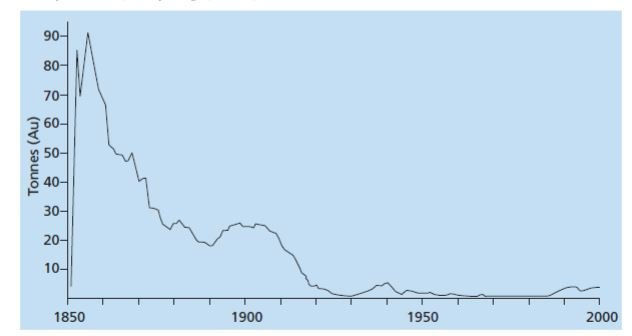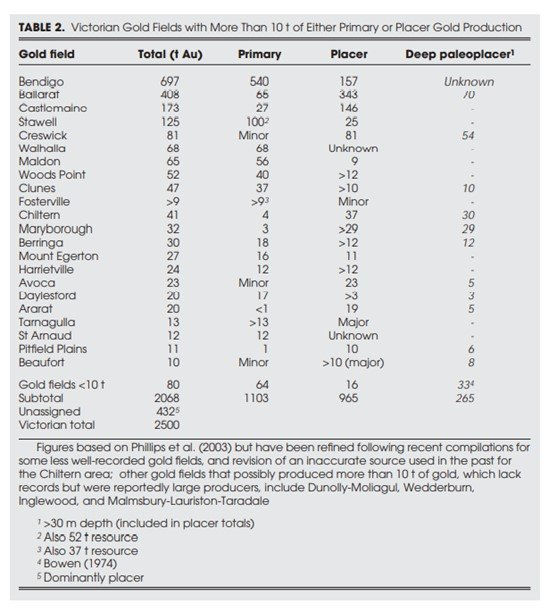Some beginners may find this background useful
The discovery of placer gold in Victoria in 1851 led to a major rush, and by the end of the year, Bendigo, Ballarat, and Castlemaine had all been discovered. For the next decade most of the 2 to 3 Moz of gold produced per year was from placer workings, and for a time nearly half the worlds gold production came from Victoria, although annual production was in steady decline after the first ten years, increasing slightly around the 1870s when the technology to mine deeply-buried alluvial gold (deep leads) was developed, and in the 1890s depression when large-scale quartz mining became important.

However, have you ever wondered why, despite the number of nuggets that continue to be found in Victoria today by metal detecting, you rarely hear of much gold coming from alluvial (placer) mining in modern Victorian streams, compared with the apparent richness of the past? Despite half of Victorias historical production being from placer gold?

It is very easy (and therefore satisfying as a hobby) to get some colours but difficult to find large quantities (and the old miners had to find an ounce a week just to keep alive). It is only partly because so many streams are now off-limits, and only partly because gold in active streams could rapidly be mined then and there were few environmental constraints. Instead it is probably because most of Victorias placer gold is not really placer (unlike the case in parts of some other major placer fields such as California), but came from palaeoplacers.
Palaeoplacers are deeply buried or uplifted river beds from at least 15 million years ago, and their present position in the topography is unrelated to modern drainage patterns. Most of these fossil rivers were much bigger than modern rivers, and contained far more gold-bearing gravel than modern streams. The alluvial gold was brought up shafts, and mined on hillsides and hilltops, and not in presently-flowing streams. Most nuggets then and now occur in their original quartz reefs, in soil downslope from them (eluvial gold), and in the old palaeoplacer valleys (where they are often now found in material thrown out around the shaft collar a hundred or more years ago). Hence the greater overall success today of detectorologists relative to people panning and sluicing in streams in many cases they are detecting palaeoplacer gold (as well as eluvial and quartz reef gold).
Hughes, M. J., Phillips, G. N. and Carey, S. P. 2004. Giant placers of the Victorian gold province, SEG Newsletter, 56, (1), 1118.
The discovery of placer gold in Victoria in 1851 led to a major rush, and by the end of the year, Bendigo, Ballarat, and Castlemaine had all been discovered. For the next decade most of the 2 to 3 Moz of gold produced per year was from placer workings, and for a time nearly half the worlds gold production came from Victoria, although annual production was in steady decline after the first ten years, increasing slightly around the 1870s when the technology to mine deeply-buried alluvial gold (deep leads) was developed, and in the 1890s depression when large-scale quartz mining became important.

However, have you ever wondered why, despite the number of nuggets that continue to be found in Victoria today by metal detecting, you rarely hear of much gold coming from alluvial (placer) mining in modern Victorian streams, compared with the apparent richness of the past? Despite half of Victorias historical production being from placer gold?

It is very easy (and therefore satisfying as a hobby) to get some colours but difficult to find large quantities (and the old miners had to find an ounce a week just to keep alive). It is only partly because so many streams are now off-limits, and only partly because gold in active streams could rapidly be mined then and there were few environmental constraints. Instead it is probably because most of Victorias placer gold is not really placer (unlike the case in parts of some other major placer fields such as California), but came from palaeoplacers.
Palaeoplacers are deeply buried or uplifted river beds from at least 15 million years ago, and their present position in the topography is unrelated to modern drainage patterns. Most of these fossil rivers were much bigger than modern rivers, and contained far more gold-bearing gravel than modern streams. The alluvial gold was brought up shafts, and mined on hillsides and hilltops, and not in presently-flowing streams. Most nuggets then and now occur in their original quartz reefs, in soil downslope from them (eluvial gold), and in the old palaeoplacer valleys (where they are often now found in material thrown out around the shaft collar a hundred or more years ago). Hence the greater overall success today of detectorologists relative to people panning and sluicing in streams in many cases they are detecting palaeoplacer gold (as well as eluvial and quartz reef gold).
Hughes, M. J., Phillips, G. N. and Carey, S. P. 2004. Giant placers of the Victorian gold province, SEG Newsletter, 56, (1), 1118.



